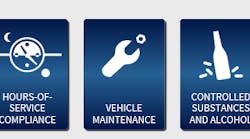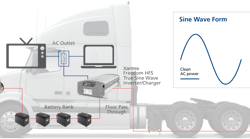In the late 1940s, auto dealers first recognized that companies utilizing several vehicles had specific needs, such as financing, maintenance assistance and other support services. Over the more than half century that’s followed, the need to combine innovation with continuity has remained an industry cornerstone. Shifts in ordering processes, OEM incentive programs and financing options all have helped transform the world of the fleet industry.
Never, however, has technological advancement reshaped the fleet industry as it is doing now. From telematics and safety, to connected cars and the dawning of autonomous vehicles, the future of the fleet landscape is being wholly reimagined.
Fleet vehicles no longer are simply a way of getting from Point A to Point B. They are a mobile workforce of computers on the road, gathering data with every step on the throttle or brake, and at every turn. The data gleaned from advanced analytics can help a fleet operate more efficiently by allowing fleet managers to better understand the factors that drive maintenance, fuel, safety and other costs, whether they occur daily or happen across the vehicle lifecycle.
Time Provides Insight
Advanced analytics provide a faster way of bringing more sources of data together, delivering insights and recommendations about engine performance, weather, location and accident information in real time. This data can be used to both streamline and simplify day-to-day activities, helping make fleets safer, smarter and more productive.
Greater insight into fleet vehicles and drivers through the use of advanced analytics also enables fleet managers to more accurately predict their maintenance spend, resulting in greater vehicle uptime, as well as better vehicle optimization and replacement scheduling.
As the meaning behind data becomes clear, fleets can learn more about their vehicles, plus analyze driver behavior and make fact-based decisions, taking targeted actions to make improvements.
Mistakes to Avoid
The goal of technology isn’t to make life harder on those who use it. Fleets should not need advanced degrees in statistical analysis in order to run their businesses, though they should be focused on understanding capabilities, limitations and pitfalls involving data.
The use of advanced analytics is still relatively new to many in the fleet industry. While business intelligence tools facilitate fleet data analysis, having the ability to sort through it quickly and easily can lead fleets to take mental shortcuts.
It’s vital to keep from over-generalizing and drawing conclusions on too little or incomplete data. Doing so increases the potential for inaccurate conclusions and thus missteps.
For example, a driver who normally drives at higher speeds may not be more likely to end up in an accident than a driver who consistently brakes harshly, indicating too little average reaction time. The fleet that only looks at vehicle speed may be missing the biggest area of risk. Dig deeper.
Small data sets create greater risk that anomalies will be generated simply by chance. Benchmarking against other fleets in order to increase the size of the data set can help to alleviate this issue.
One more element to remember is that point estimates are not always useful. A value could vary quite a bit from the average, yet still be within a normal and expected range. The average doesn't tell you the full story. Reporting an expected range of values is often more informative.
With so much data available, fleets must be cognizant of aligning tracked data with their company’s strategic objectives. For example, if fuel efficiency is one of your top goals, make it a data priority. Track data such as how often an asset is refueled, what kind of fuel is being used and how much distance is traveled. This will save time and money, and increase efficiency.
There are so many variables to track that sometimes two completely unrelated variables will correlate purely by random chance. Be careful about drawing inferences when two independent trends move together.
Analytics and the Future
We are truly at the beginning of a new frontier of data intelligence which will continue to reshape the fleet industry for generations to come. The use of advanced analytics to examine large data sets will enable fleet management companies and fleets to unearth previously unknown correlations, trends and star drivers, as well as those who need additional safety training and other actionable insights.
For those who haven’t jumped on the data bandwagon, now is the time. Increased safety, efficiency and profit is right around the corner.
Bill Jones is director of product management and Jim Peregord is vice president of analytics, business intelligence and data management for Element Fleet Management (www.elementfleet.com). Element Fleet Management is a global leader in the fleet management industry, providing world-class fleet management services that empower extraordinary results across the total fleet lifecycle.





